不同温度下樱桃番茄有氧呼吸速率的测定及其应用
2023-09-14尹兴黄震崔久刚冯洁张洋
尹兴,黄震,崔久刚,冯洁,张洋
不同温度下樱桃番茄有氧呼吸速率的测定及其应用
尹兴1a,黄震2,崔久刚1b,冯洁3,张洋1a
(1.天津职业大学 a.包装与印刷工程学院 b.基础课部,天津 300410; 2.天津商业大学 机械工程学院,天津 300410;3.天津科技大学 轻工学院,天津 300457)
研究不同温度下樱桃番茄的呼吸速率,并用模型参数进行表征。有氧条件下采用密闭系统,在温度为0~30 ℃内测定樱桃番茄在不同时间的气体体积分数,计算O2的消耗速率和CO2的生成速率。对樱桃番茄的呼吸过程用Michaelis-Menten模型的进行数学拟合。25 ℃下,应用呼吸速率模型选择樱桃番茄的最佳包装材料。结果表明,樱桃番茄的呼吸速率符合Michaelis-Menten模型,决定系数2均大于0.9,回归较好。樱桃番茄的呼吸动力学温度依赖性可以用Arrhenius方程进行表征,决定系数2>0.99。同时应用Michaelis-Menten模型验证PE1和PE22种材料,得出PE1袋更适合作为樱桃番茄的包装材料。Michaelis-Menten模型对樱桃番茄保鲜有重要意义。
樱桃番茄;有氧呼吸;Michaelis-Menten模型;Arrhenius方程;保鲜
樱桃番茄具有很高的营养价值,它含有13种维生素和17种矿物质,更重要的是它富含番茄红素[1-3]。番茄红素是一种抗氧化剂,具有降低血压和胆固醇、保护心脏和预防癌症的作用[4-5]。因此,樱桃番茄的市场需求持续增长,它已在我国海南省广泛种植,甚至成为主要的冬季作物[6]。然而,樱桃番茄属于一种呼吸跃变型水果,采摘后有明显的呼吸高峰[7]。在储存和运输过程中,樱桃番茄可能会因呼吸和蒸腾作用严重失水而变软。果蔬呼吸作用是有机物质在氧气的参与下分解为二氧化碳和水,从而引起果蔬的腐烂变质。气调包装是提高果蔬货架寿命的有效手段,呼吸速率是进行气调包装的关键。
目前,关于动态调整樱桃番茄气调保鲜参数的问题研究较少,而确定准确呼吸速率模型是解决樱桃番茄气调包装的关键。本文以樱桃番茄为研究对象,在不同温度下,测试樱桃番茄的O2和CO2体积分数并计算其呼吸速率。对实验数据进行回归,建立不同温度下呼吸速率随着O2和CO2体积分数变化的Michaelis-Menten模型,呼吸速率与温度的Arrhenius方程。最后,应用呼吸速率模型选择樱桃番茄的最佳包装材料。
1 实验
1.1 方法
国内外学者就不同果蔬的呼吸速率及其模型进行了大量的研究,见表1。从表1中可以看出,果蔬特性不同,其呼吸速率差别较大,采用得较多的测试呼吸速率的方法是密闭系统法;关于呼吸速率拟合的模型有Hagger type模型、Quadratic function模型和 Michaelis-Menten模型3种,这些都为果蔬进行气调保鲜提供了参考依据。
本文采用的实验装置是自制的密闭系统,如图1所示,与文献中报道的相似[15,24],它主要由气体交换呼吸计和气体分析仪组成。呼吸计包括密封室和密封盖,盖中心有一个孔,并为其粘贴橡胶以保证气密。采摘天津生态园八成熟的“千禧”樱桃番茄,采收当天立即运送至实验室,挑选无机械损伤、大小一致的果实进行试验,单果质量约为15 g,硬度为(2.50±0.15)kg/cm2。将樱桃番茄放入呼吸计中,使用Witt顶空分析仪(CheckMate③, Metech|mocon,丹麦)测试呼吸计内的气体体积分数。研究的测试温度为0、5、10、15、20、25和30 ℃,樱桃番茄的质量及其相应的自由体积如表2所示。呼吸计的自由体积为呼吸计容积减去樱桃番茄所占的体积。每个测试温度下取5个平行样品进行测量并求平均值。
表1 国内外学者研究的各种果蔬的呼吸速率及其模型
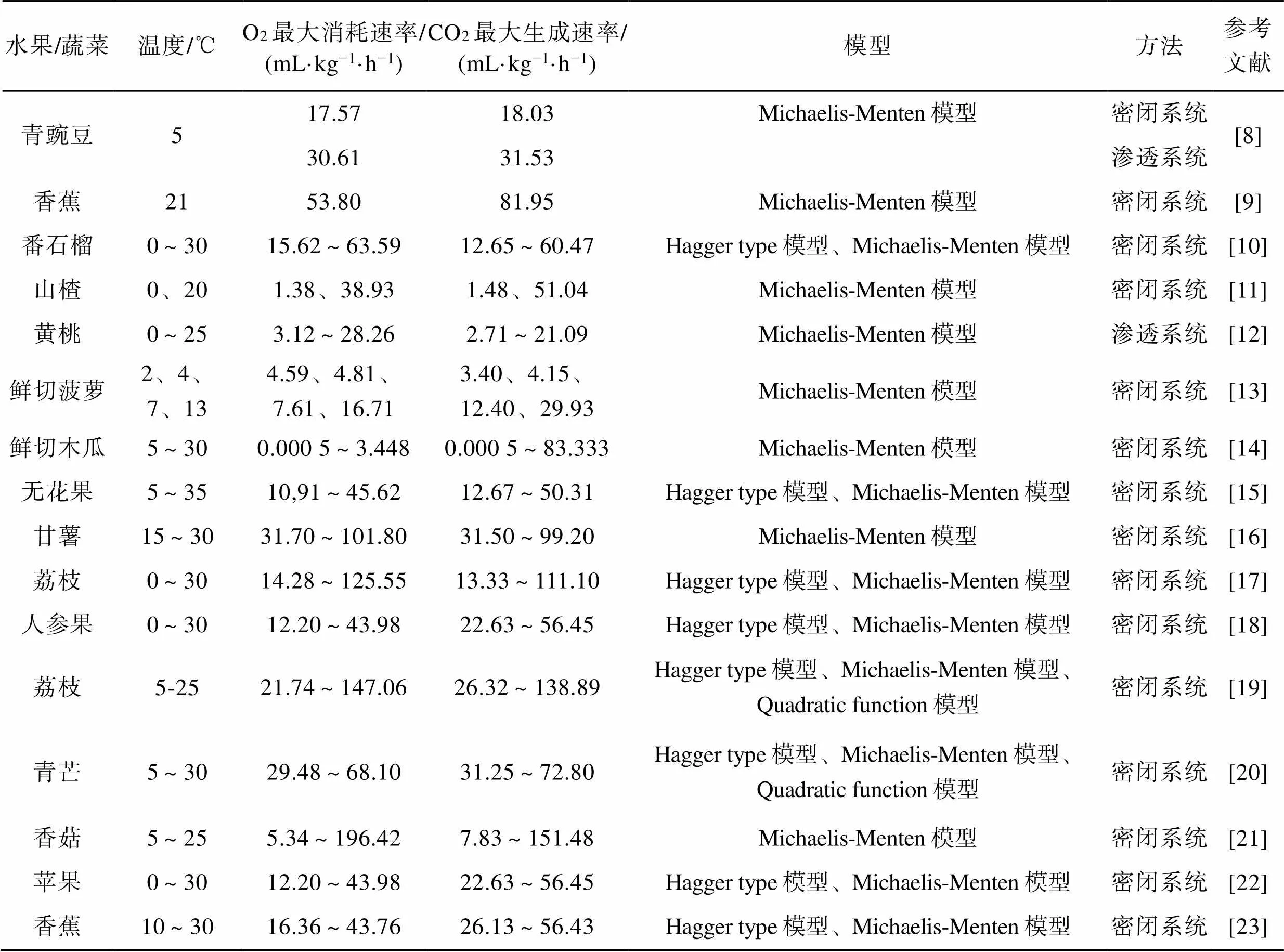
Tab.1 Respiration rate and its model of various fruits and vegetables studied by Chinese and foreign scholars
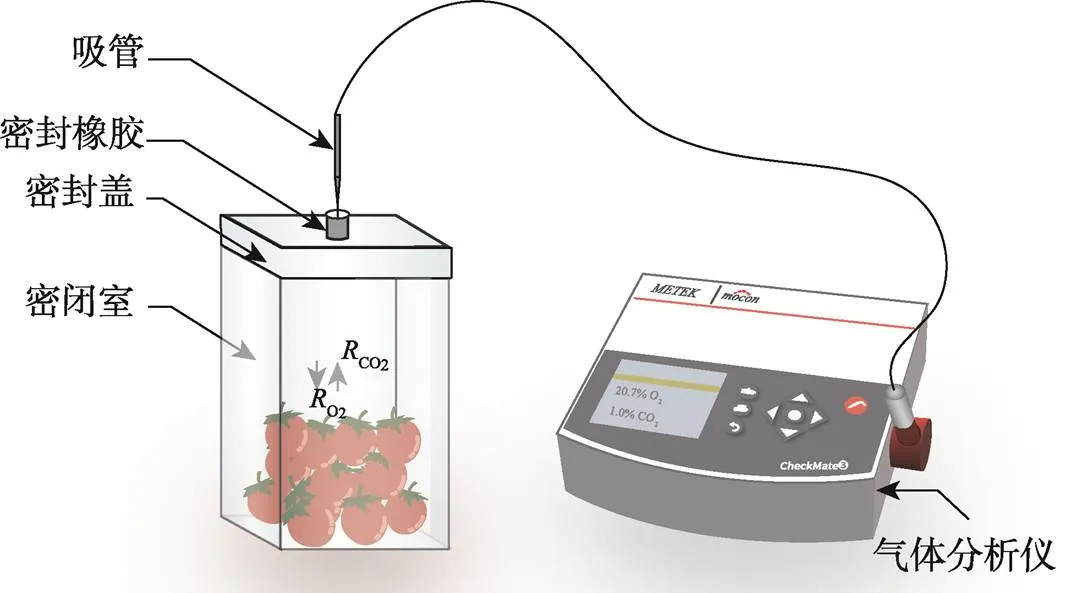
图1 用于测量樱桃番茄气体体积分数的实验装置示意图
表2 计算樱桃番茄呼吸速率的基础数据
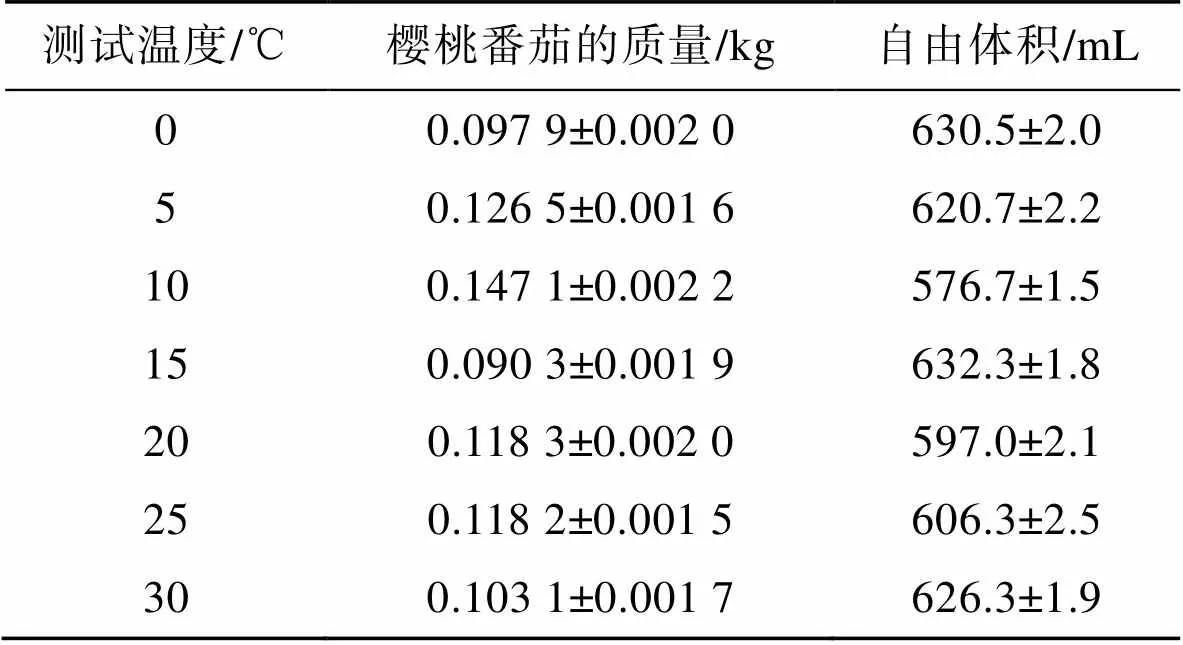
Tab.2 Basic data for calculating respiration rate of cherry tomato
1.2 呼吸速率的计算
测试O2和CO2的体积分数以计算樱桃番茄的呼吸速率。呼吸速率可以用O2的消耗速率和CO2的生成速率表示,见式(1)和式(2)[9,17]。


1.3 模型Michaelis-Menten模型
众所周知,果蔬的有氧呼吸为有机物质在酶的参与下进行氧化分解同时释放能量,见式(3)。

Lee等[25]描述了新鲜农产品的酶促呼吸过程,通过假设CO2的非竞争性抑制作用,提出了2个关于O2消耗和CO2生成速率的Michaelis-Menten公式,见式(4)和式(5)。


使用SPSS软件对实验数据进行多元回归分析,可以得到Michaelis-Menten模型参数。
1.4 Arrhenius方程
温度对果蔬的呼吸活动有重要影响。通过文献[10, 14-15]可知,储存环境中每增加10 ℃,呼吸速率会增加2~3倍。文献[10]研究了温度与番石榴呼吸速率之间的关系,并用Arrhenius方程进行了拟合。Arrhenius方程见式(6)。

1.5 模型应用
应用呼吸速率模型选择樱桃番茄的最佳包装材料。选用2种不同的聚乙烯(PE)袋,表3分别给出了2种类型PE袋(标为PE1和PE2)的不同参数。样品放入温度为25 ℃、相对湿度为50%的恒温恒湿箱内,见图2。储存期内,通过使用气体成分分析仪定期测量袋子中O2和CO2的体积分数,计算渗透系统的呼吸速率,选择最适合樱桃番茄的包装材料。
表3 PE包装材料的参数

Tab.3 Parameters of PE packaging materials
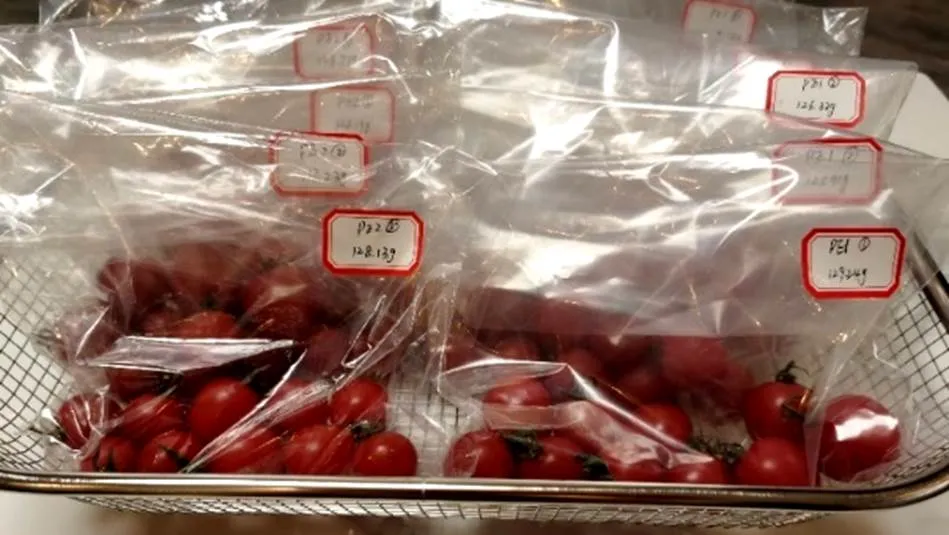
图2 不同材料包装的樱桃番茄样品
2 结果与分析
2.1 气体体积分数的变化
温度对果蔬的呼吸速率有很大影响,因此选择了0、5、10、15、20、25和30 ℃ 7个温度来研究温度对樱桃番茄呼吸作用的影响。图3显示了不同测试温度下O2和CO2体积分数的变化。可以看出,随着测试时间的推移,O2体积分数降低,而CO2体积分数增高。同时,O2体积分数降低和CO2体积分数增高的幅度在低温下相对平缓。相反,在高温下,O2体积分数降低和CO2体积分数增高的幅度变化较大。O2和CO2的初始气体体积分数分别为20.7%和0.6%。测试48 h后,O2体积分数在0、5、10、15、20、25和30 ℃时分别降至18.5%、17.3%、15.3%、13.0%、11.7%、8.1%和6.9%。同时,CO2体积分数分别增加至2.7%、4.5%、6.9%、8.8%、10.4%、13.0%和17.1%。可以看出,温度越高,樱桃番茄的呼吸越剧烈,因此,消耗的O2越多,产生的CO2就越多。同时发现,在25 ℃下,贮藏48 h后检测O2体积分数为8.1%,CO2体积分数达到13.0%;在30 ℃下,贮藏48 h后检测O2体积分数为6.9%,CO2体积分数达到17.1%。原因是高温下,呼樱桃番茄强烈的呼吸作用使得O2被大量消耗,CO2大量生成。此时打开包装时,能闻到轻微的酒精味道,说明此时樱桃番茄已经开始了无氧呼吸,这会加速樱桃番茄的腐败。
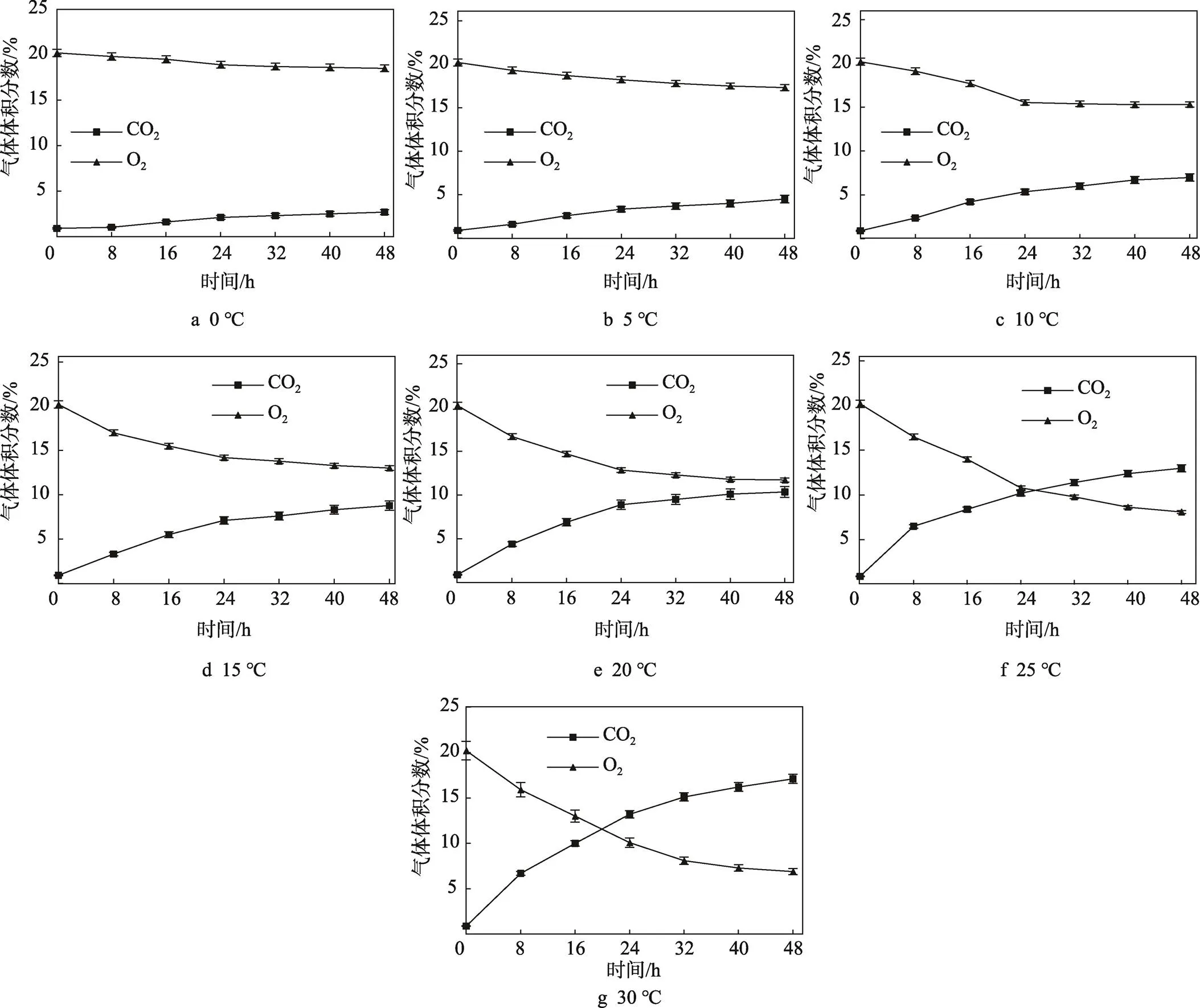
图3 不同温度下密闭系统中O2和CO2体积分数的变化
2.2 呼吸速率的变化
温度影响樱桃番茄的呼吸作用,随着温度的升高,密闭系统内CO2的生成速率和O2的消耗速率越大。将图3中的O2和CO2体积分数代入式(1)和式(2)中即可计算CO2的生成速率和O2的消耗速率,得到的结果如图4所示。
由图4可以看出,在贮藏初期,CO2的生成速率和O2的消耗速率都快速下降。实验开始后,在0~30 ℃条件下,O2的初始消耗速率分别为5.0、8.8、12.2、17.8、25.5、31.9、43.3 mL/(kg·h);24 h时,在0~30 ℃条件下,O2的消耗速率分别为3.4、4.8、6.8、11.4、14.4、22.4、26.5 mL/(kg·h),O2消耗速率分别下降了32%、45.5%、44.3%、34.0%、43.5%、29.8%、38.8%。在0~30 ℃条件下,CO2的初始生成速率分别为4.5、7.3、10.3、17.1、24.7、31.6、42.9 mL/(kg·h);24 h时,在0~30 ℃条件下,CO2的生成速率分别为3.6、5.7、7.1、12.8、16.7、22.8、29.2 mL/(kg·h),CO2的生成速率分别下降了20%、21.9%、31.1%、25.1%、32.4%、27.8%、31.9%。通过数据可以看出,温度越高,呼吸速率越大,樱桃番茄的呼吸活动越强;温度越低,呼吸速率越小,呼吸活动越弱,说明低温能够有效抑制果蔬的呼吸作用。不同温度下,樱桃番茄的呼吸速率随着贮藏时间的延长而降低。原因是密闭系统中的O2体积分数逐渐降低,而CO2体积分数逐渐升高,高体积分数的CO2和低体积分数的O2都会抑制樱桃番茄的呼吸活动,因此呼吸速率下降。
2.3 Michaelis-Menten模型
根据式(4)和式(5),对呼吸速率数据进行非线性拟合,表4中列出了Michaelis-Menten 模型参数以及每个温度下相应的2值。
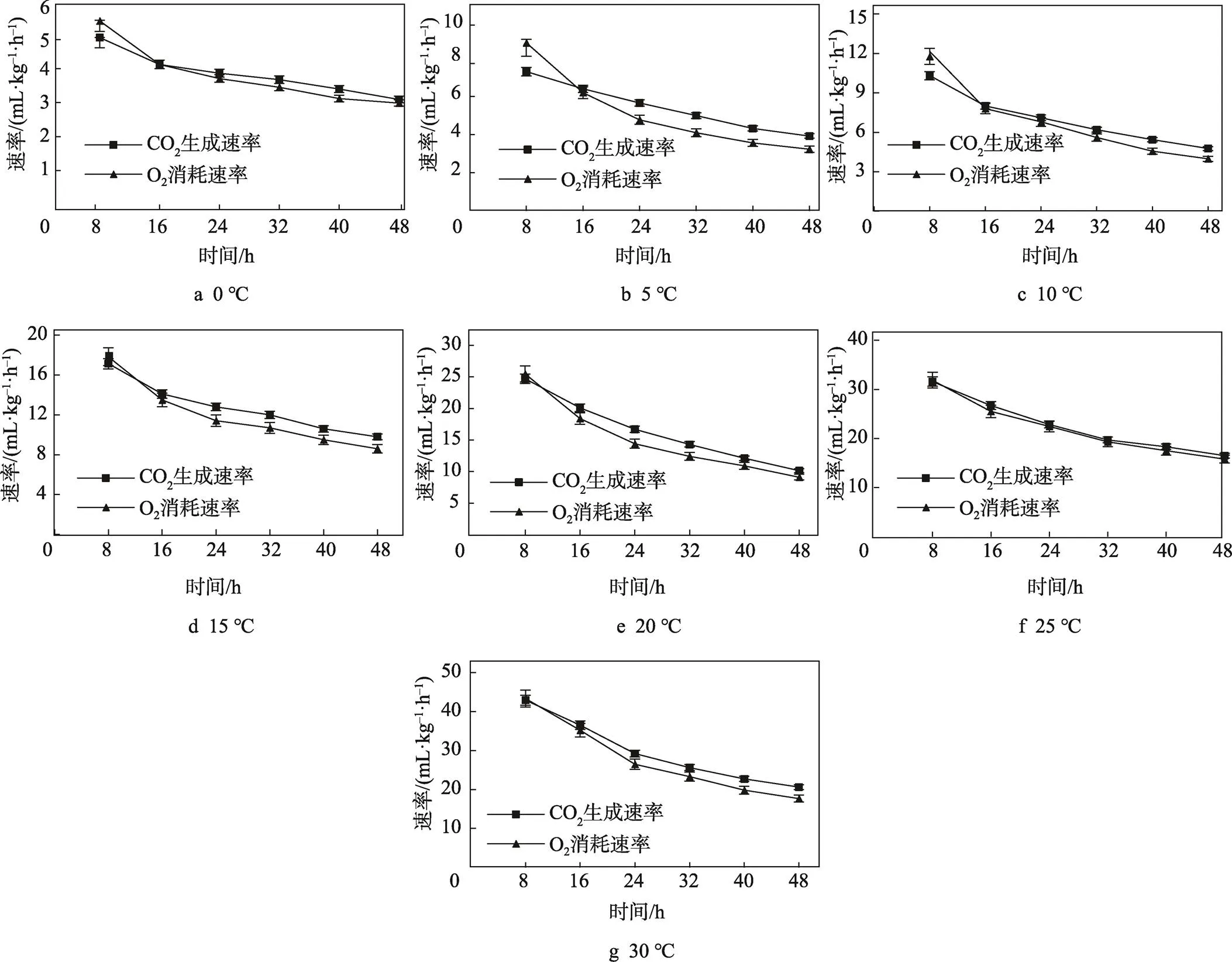
图4 不同温度下樱桃番茄呼吸速率
表4 Michaelis-Menten模型参数
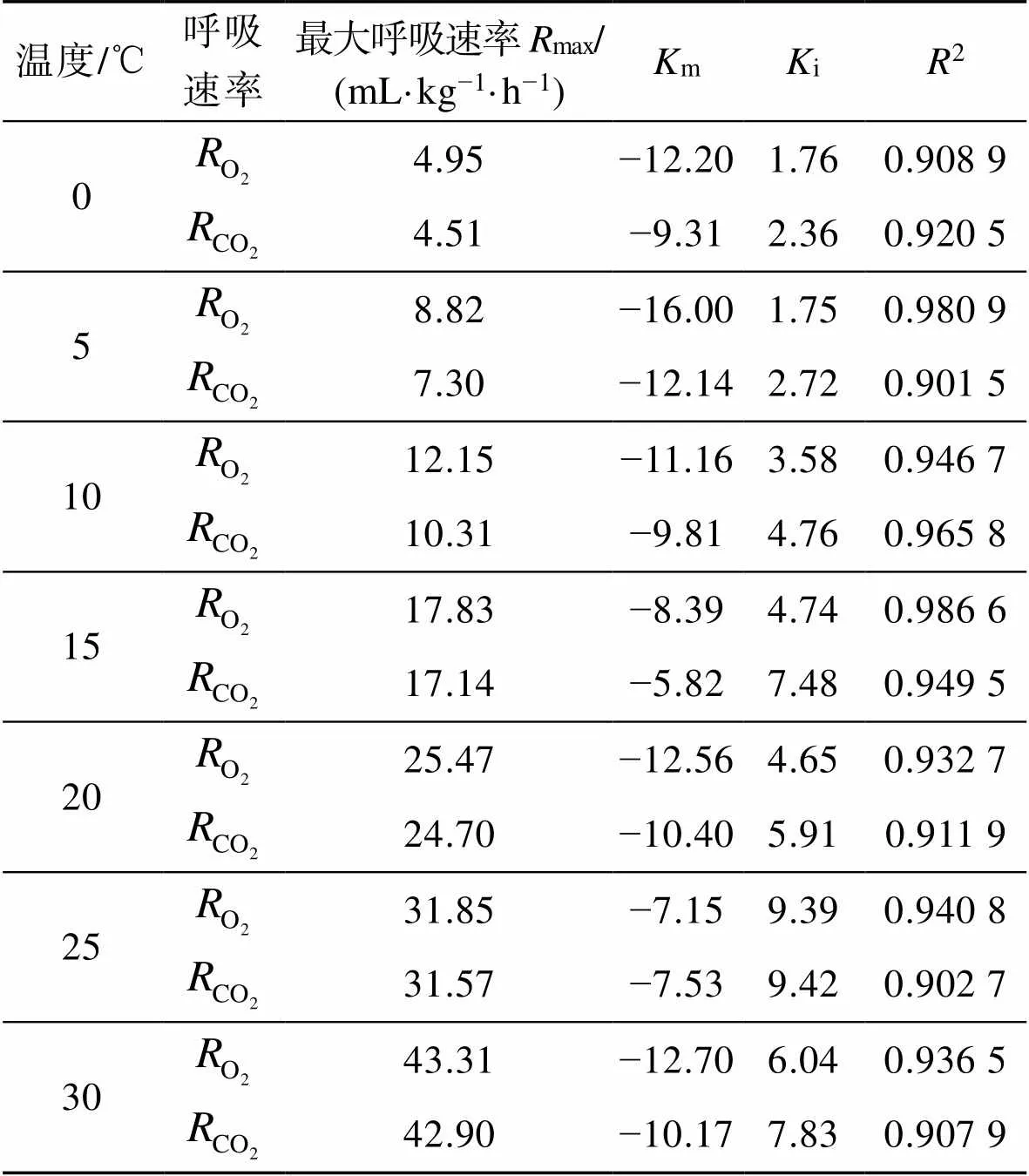
Tab.4 Parameters of Michaelis-Menten model
根据表4可以看出Michaelis-Menten模型参数和测试温度极为相关。例如,0 ℃时,max、m和i3个参数数值分别为4.95 mL/(kg·h)、−12.20和1.76;10 ℃时,这3个参数数值分别为12.15 mL/(kg·h)、−11.16和3.58;20 ℃时,3个参数数值变为25.47 mL/(kg·h)、−12.56和4.65。这些数据表明,温度越高,樱桃番茄的最大呼吸速率越高,这与Rovira等[24]所研究的结果相似。同时,回归系数2的值高于0.9,表明模型可以很好地反映呼吸速率、O2、CO2体积分数之间的关系。
2.4 Arrhenius方程
2.5 呼吸速率模型应用
使用模型3评估渗透系统的呼吸速率,根据表6中的结果,樱桃番茄在25 ℃下的呼吸速率的2个表达式,见式(7)和式(8)。


在贮藏期间,2个PE袋和密闭系统内O2和CO2体积分数变化如图6所示。可以看出,随着储存时间的增加,O2体积分数降低,CO2体积分数增大。这是因为樱桃番茄的呼吸活动导致了O2的消耗和CO2的产生。此外,观察到3个系统的O2体积分数按照PE2、PE1、密闭系统的顺序降低,而CO2体积分数的变化则相反。由表3显示可知,PE2袋具有比PE1袋更高的O2渗透性,并且2个PE袋比密闭系统渗透性高。PE袋内O2体积分数高于密闭系统中O2体积分数,而PE袋外部CO2体积分数可以忽略不计。很明显,更多的气体分子可以穿过渗透性更强的系统。因此,在储存期间,更多的O2会渗入,同时更多的CO2会渗出。贮藏48 h时,PE1袋O2体积分数为9.4%、CO2体积分数为9.1%;PE2袋的O2体积分数为14.6%、CO2体积分数为3.3%;密闭系统中,O2体积分数为7.9%、CO2体积分数为13.2%。PE1袋和PE2袋中的樱桃番茄均未出现酒精的味道,而密闭系统的樱桃番茄有酒精的味道。说明密闭系统的樱桃番茄在25 ℃下贮藏48 h后发生了无氧呼吸,而PE1袋和PE2袋中樱桃番茄依然进行的是有氧呼吸。

图5 樱桃番茄的最大呼吸速率与温度的关系
表5 基于Arrhenius方程的计算结果

Tab.5 Calculation results based on Arrhenius relation

图6 不同袋中樱桃番茄的O2和CO2体积分数变化曲线
樱桃番茄最适合的气调包装环境:O2体积分数为2%~5%、CO2体积分数为3%~5%[26]。在贮藏24 h后,O2体积分数和CO2体积分数达到平衡,此时PE1袋中的O2体积分数为9.4%~10.7%,CO2体积分数为8.1%~9.1%,PE2袋中的O2体积分数为14.6%~16.0%,CO2体积分数为2.8%~3.3%。根据式(7)和式(8)分别对O2消耗率和CO2生成率进行计算,结果见图7。可以看出,随着时间的增加,O2的消耗速率和CO2的生成速率为从大到小排序为PE2、PE1、密闭系统。结果表明Michaelis-Menten模型既适用于密闭系统,也适用于渗透系统,而渗透性较低的包装系统更有利于抑制樱桃番茄的呼吸作用。因此,PE1袋比PE2袋更适合作为樱桃番茄的包装材料,在保鲜鲜切土豆[27]中也有类似的研究。
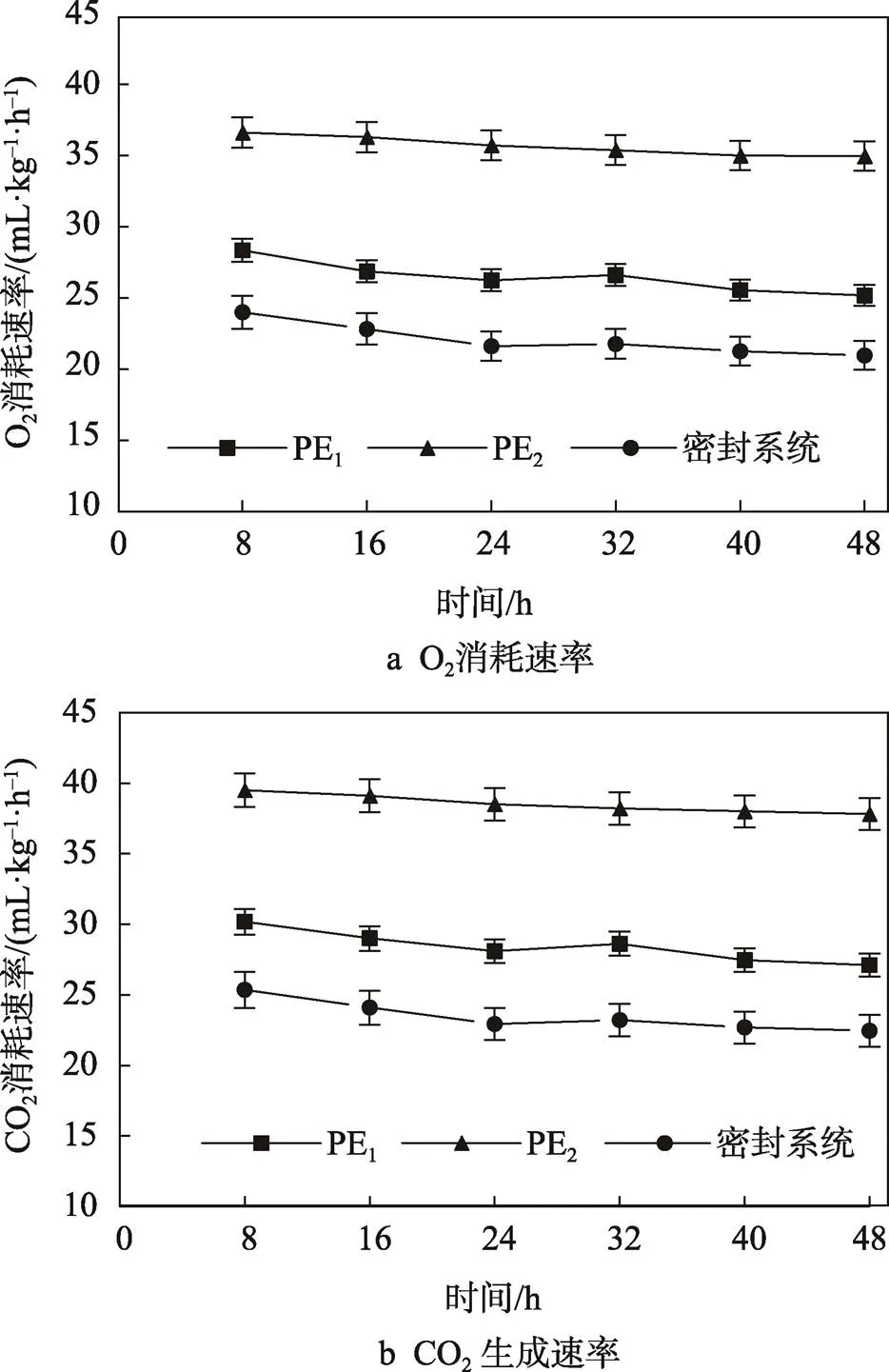
图7 不同系统中樱桃番茄呼吸速率的比较
3 结语
本文以樱桃番茄为研究对象,拟合了其呼吸速率模型,解决了其在气调保鲜包装中参数较少的问题。
1)采用密闭系统的方法,在0、5、10、15、20、25和30 ℃下测试樱桃番茄的O2和CO2体积分数,计算其呼吸速率,并进行非线性回归;根据Michaelis- Menten模型建立了樱桃番茄的呼吸模型参数,决定系数2均大于0.9,回归较好。
2)樱桃番茄的呼吸动力学温度依赖性可以用Arrhenius方程进行表征,拟合值2>0.99。
3)25 ℃下,将Michaelis-Menten模型用于评估樱桃番茄的渗透包装系统,结果表明低渗透性PE1袋中樱桃番茄的呼吸速率低于高渗透性PE2袋中樱桃番茄的呼吸速率,PE1袋更适合作为樱桃番茄的包装材料。
[1] TILAHUN S, LEE Y M, CHOI H R, et al. Modified Atmosphere Packaging Combined with CO2and 1-Methylcyclopropene Prolong the Storability and Maintain Antioxidant Properties of Cherry Tomato[J]. Scientia Horticulturae, 2011, 288: 110401.
[2] DOWAN K, SARINTHIP T, KAEUN L, et al. Smart Packaging with Temperature-Dependent Gas Permeability Maintains the Quality of Cherry Tomatoes[J]. Food Bioscience, 2021, 41: 100997.
[3] MUSTAPHA A, ZHOU Cun-shan. Novel Assisted/Unassisted Ultrasound Treatment: Effect on Respiration Rate, Ethylene Production, Enzymes Activity, Volatile Composition, and Odor of Cherry Tomato[J]. LWT, 2021, 149: 111779.
[4] JOUNG M, SHIN Y. Physicochemical Quality, Antioxidant Compounds, and Activity of 'Beta Tiny' and 'TY Nonari' Cherry Tomatoes during Storage[J]. Korean Society Food Science Technology. 2021, 53(1): 63-71.
[5] RAPISARDA M, PATANÈ C, PELLEGRINO A, et al. Compostable Polylactide and Cellulose Based Packaging for Fresh-Cut Cherry Tomatoes: Performance Evaluation and Influence of Sterilization Treatment[J]. Materials, 2020, 13(15): 3432.
[6] 伍壮生, 李雪峤, 吴月燕, 等. 海南樱桃番茄生产现状及发展瓶颈分析[J]. 中国蔬菜, 2018(5): 98-100.
WU Zhuang-sheng, LI Xue-jiao, WU Yue-yan, et al. Production Status and Development Bottleneck Analysis of Cherry Tomato in Hainan[J]. China Vegetables, 2018(5): 98-100.
[7] PAN X L, KOU W Q, SONG L R. Effects of Different Preservatives Treatments on Cherry Tomatoes Preservation [J]. Storage and Process, 2021, 21(11): 34-42.
[8] 卢立新, 陶瑛. 青豌豆呼吸速率的测定与模型表征[J]. 食品与生物技术学报, 2006, 25(2): 33-36.
LU Li-xin, TAO Ying. Respiration Rate Measurement and Mathematical Modelling for Pea[J]. Journal of Food Science and Biotechnology, 2006, 25(2): 33-36.
[9] HEYDARI A, SHAYESTEH K, EGHBALIFAM N, et al. Studies on the Respiration Rate of Banana Fruit Based on Enzyme Kinetics[J]. International Journal of Agriculture and Biology, 2010, 12(1): 1560-8530.
[10] MANGARAJ S, GOSWAMI T K. Measurement and Modeling of Respiration Rate of Guava (CV. Baruipur) for Modified Atmosphere Packaging[J]. International Journal of Food Properties, 2011, 14(3): 609-628.
[11] 冉令省, 王志超, 王美兰. 基于Michaelis-Menten型山楂呼吸模型的建立[J]. 食品科技, 2015, 40(8): 330-333.
RAN Ling-xing, WANG Zhi-chao, WANG Mei-lan, et al. Hawthorn Respiration Model on Michaelis-Menten Type[J]. Food Science and Technology, 2015, 40(8): 330-333.
[12] 刘颖, 李云飞, 王如竹, 等. 基于Michelis-Menten型呼吸速率模型的实验研究[J]. 上海交通大学学报, 2004, 38(7): 1170-1173.
LIU Ying, LI Yun-fei, WANG Ru-zhu, et al. Experimental Study on Michaelis-Menten Type Respiration Model[J]. Journal of Shanghai Jiao Tong University, 2004, 38(7): 1170-1173.
[13] BEN S, CHIUMENTI M, SEPULCRE F, et al. Modeling the Effect of Storage Temperature on the Respiration Rate and Texture of Fresh-Cut Pineapple[J]. Journal of Food Engineering, 2012, 113(4): 527-533.
[14] RAHMAN E, A TALIB R, AZIZ M, et al. Modelling the Effect of Temperature on Respiration Rate of Fresh Cut Papaya (Carica Papaya L.) Fruits[J]. Food Science and Biotechnology, 2013, 22(6): 1581-1588.
[15] GHOSH T, DASH K. Modeling on Respiration Kinetics and Modified Atmospheric Packaging of Fig Fruit[J]. Journal of Food Measurement and Characterization, 2020, 14(2): 1092-1104.
[16] HAN S H, JANG H D, LEE S J. Modeling Respiration Rates of(Sweet Potato) under Hermetic Storage System[J]. Food Science and Biotechnology, 2020, 29(2): 227-234.
[17] MANGARAJ S, GOSWAMI T K. Modeling of Respiration Rate of Litchi Fruit under Aerobic Conditions[J]. Food and Bioprocess Technology, 2011, 4(2): 272-281.
[18] DASH K K, RAVINDRA M R, GOSWAMI T K. Modeling of Respiration Rate of Sapota Fruit Under Aerobic Conditions[J]. Journal of Food Process Engineering, 2009, 32(4): 528-543.
[19] 夏晶晶, 虞新新, 吕恩利, 等. 不同贮藏温度下荔枝呼吸速率模型的对比与验证[J]. 农业工程学报, 2018, 34(10): 267-273.
XIA Jing-jing, YU Xin-xin, LYU En-li, et al. Comparison and Verification of Respiratory Rate Models of Litchi under Different Storage Temperatures[J]. Transactions of the Chinese Society of Agricultural Engineering, 2018, 34(10): 267-273.
[20] RAVINDRA M, GOSWAMI T K. Modelling the Respiration Rate of Green Mature Mango under Aerobic Conditions[J]. Biosystems Engineering, 2008, 99(2): 239-248.
[21] 聂恒威, 卢立新, 潘嘹, 等. 基于温湿度影响的香菇呼吸速率测定与模型表征[J]. 食品工业科技, 2019, 40(16): 223-228.
NIE Heng-wei, LU Li-xin, PAN Liao, et al. Respiration Rate Measurement and Mathematical Modelling of Shiitake on Different Storage Temperature and Relative Humidity[J]. Science and Technology of Food Industry, 2019, 40(16): 223-228.
[22] MAHAJAN P V, GOSWAMI T K. Enzyme Kinetics Based Modelling of Respiration Rate for Apple[J]. Journal of Agricultural Engineering Research, 2001, 79(4): 399-406.
[23] BHANDE S D, RAVINDRA M R, GOSWAMI T K. Respiration Rate of Banana Fruit under Aerobic Conditions at Different Storage Temperatures[J]. Journal of Food Engineering, 2008, 87(1): 116-123.
[24] ROVIRA D, ALFARO C, MARTÍNEZ V, et al. Respiration Rate and Shelf‑Life Study of Crotalaria Longirostrata (Chipilín)[J]. Journal of Food Measurement and Characterization, 2019, 13: 3025-3032.
[25] LEE D S, HAGGAR P E, LEE J, et al. Model for Fresh Produce Respiration in Modified Atmosphere Based on Principles of Enzyme Kinetics[J]. Journal of Food Science, 2006, 56(6): 1580-1585.
[26] 齐小晶. 聚己内酯/氧化硅薄膜的制备及其在樱桃番茄自发气调包装中的应用[D]. 呼和浩特: 内蒙古农业大学, 2017.
QI Xiao-jing. Preparation of Poly (ε-caprolactone)/SiOxFilm and Application of the Film on Equilibrium Modified Atmosphere Packaging of Cherry Tomato[D].
[27] 柳俊超. 三种鲜切蔬菜的气调包装设计[D]. 石河子: 石河子大学, 2015.
LIU Jun-chao. Modified Atmosphere Packaging Design of Three Kinds of Fresh-Cut Vegetables[D]. Shihezi: Shihezi University, 2015.
Determination and Application of Aerobic Respiration Rates of Cherry Tomato at Different Temperature
YIN Xing1a, HUANG Zhen2, CUI Jiu-gang1b, FENG Jie3, ZHANG Yang1a
(1. a. School of Packaging and Printing Engineering b. Basic Course Teaching Department, Tianjin Vocational Institute, Tianjin 300410, China; 2. Mechanical Engineering College, Tianjin University of Commerce, Tianjin 300410, China; 3. School of Light Industry Science and Engineering, Tianjin University of Science & Technology, Tianjin 300457, China)
The work aims to study the respiration rates of cherry tomatoes at different temperature and characterize the rates with model parameters. Under aerobic conditions, a closed system was adopted and the time-dependent gas concentrations of cherry tomatoes in the closed system were determined over the temperature range of 0-30 °C to calculate the O2consumption rate and CO2generation rate. The respiration process of cherry tomatoes was mathematically correlated with enzymatic Michaelis-Menten model. The best packaging material of cherry tomatoes was selected by respiration rate model at 25 °C. The results indicated that the respiration rate of cherry tomatoes was consistent with the Michaelis-Menten model. The determination coefficient2was greater than 0.9, and the regression was good. The temperature dependence of respiratory dynamics of cherry tomatoes could be characterized by Arrhenius equation and the determination coefficient was2>0.99. At the same time, the Michaelis-Menten model was used to verify PE1and PE2, and it was concluded that PE1 bag was more suitable for packaging cherry tomato. Michaelis-Menten model is important for cherry tomato preservation.
cherry tomato; aerobic respiration; Michaelis-Menten model; Arrhenius equation; preservation
S377
A
1001-3563(2023)17-0050-09
10.19554/j.cnki.1001-3563.2023.17.007
2023-03-07
2020年度天津市教委科研计划项目(2020KJ070)
责任编辑:曾钰婵
